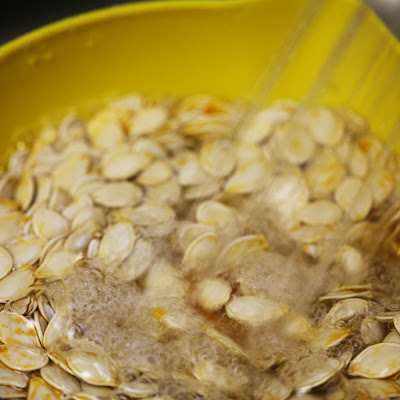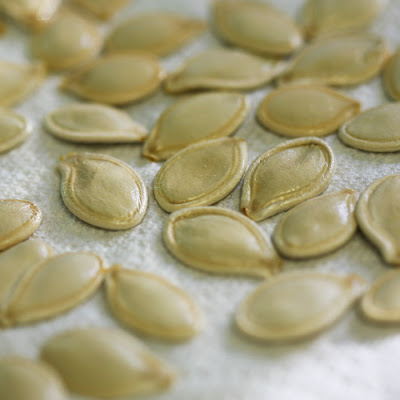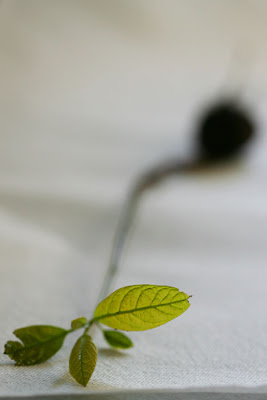The answer is a big resounding yes!! I wrote this post about harvesting and saving the seeds, and I planted the seeds shown in those photographs in my garden a couple of months ago.
Well here is a photograph, taken today (July 4, 2010 - happy Independance Day to our friends south of the border! :) and as you can see, the seeds worked very well. Next we'll see what kind of pumpkins will result from my efforts. I'll keep you posted!
Plant Avenue Home
Twitter Talk:
Success At Growing Strawberry Runners
It worked!
I tried planting strawberry runners while they were still attached to their mother plants, and lo and behold, I went from having six plants last year (which I purchased from a nursery), to having close to thirty this year.
First I lined up my original six in a row. I then took small pots filled with earth, raised them up off the ground (using other overturned pots) so that they would reach the runners, and then simply pushed the runners into the soil in the pots. I left them there all winter, and sure enough, they thrived. A couple of weeks ago I cut them free from their mother plants and transplanted them into larger pots (most were root bound at this point).
I'm not sure how many will produce berries. I've heard that plants produce more berries if you cut off their runners, so I think I'll try this with about half of them and see what happens. Meanwhile, I'm starting to feel like I run a strawberry plant nursery :)
Plant Avenue Home
I tried planting strawberry runners while they were still attached to their mother plants, and lo and behold, I went from having six plants last year (which I purchased from a nursery), to having close to thirty this year.
First I lined up my original six in a row. I then took small pots filled with earth, raised them up off the ground (using other overturned pots) so that they would reach the runners, and then simply pushed the runners into the soil in the pots. I left them there all winter, and sure enough, they thrived. A couple of weeks ago I cut them free from their mother plants and transplanted them into larger pots (most were root bound at this point).
I'm not sure how many will produce berries. I've heard that plants produce more berries if you cut off their runners, so I think I'll try this with about half of them and see what happens. Meanwhile, I'm starting to feel like I run a strawberry plant nursery :)
Plant Avenue Home
Labels:
Propagation,
Strawberries
Time To Get Gardening?
I'll admit it - I'm a fair weather gardener ;) I haven't been up to much this winter, other than watering my indoor plants and mulling over how to compost with frozen ground.
Now, nearing the end of January, we're having strangely warm weather for my area (south coast of BC, Canada). Bulbs are sprouting everywhere, making residents here question the temperatures of days to follow. There are even those who have already planted flowering plants in their garden beds, waiting to welcome spring.
Will the unseasonably warm trend continue into February? (It's bad timing with the Olympics coming to town - we need snow on the hills!!) Can we start our gardens early? It's soooo tempting to start making rows in the soil and dropping seeds - anything to extend our growing season!! I took a chance last year and started early and it worked out well, but planting seeds in January? (OK maybe not ;)
Meanwhile there is a lot I can get started on... pulling weeds, working the soil, and so on. Spring is just around the corner... I can't wait!!
Plant Avenue Home
Now, nearing the end of January, we're having strangely warm weather for my area (south coast of BC, Canada). Bulbs are sprouting everywhere, making residents here question the temperatures of days to follow. There are even those who have already planted flowering plants in their garden beds, waiting to welcome spring.
Will the unseasonably warm trend continue into February? (It's bad timing with the Olympics coming to town - we need snow on the hills!!) Can we start our gardens early? It's soooo tempting to start making rows in the soil and dropping seeds - anything to extend our growing season!! I took a chance last year and started early and it worked out well, but planting seeds in January? (OK maybe not ;)
Meanwhile there is a lot I can get started on... pulling weeds, working the soil, and so on. Spring is just around the corner... I can't wait!!
Plant Avenue Home
Soluble Salts

Mystery solved!! I'd always wondered what that white build up was on the soil of my house plants, and now I know! It's soluble salts: minerals or fertilizers that are dissolved in water, and are left behind to accumulate after normal evaporation of water.
I used to just take a spoon and mix them back into the soil... oops (don't do that!!). Instead you should scoop the whitish and yellowish film off the top of the soil and discard it. Soluble salts that are present in the soil in concentrations that are too high can damage the plant.
Here's some info:
- Salts form a yellow or white crust at the top of the soil or at the bottom at the drainage holes.
- They can cause salt toxicity, which can result in reduced growth, brown leaf tips, leaf dropping, wilting, root damage, root rot, reduced water absorption capacity.
- Prevention: when you water, allow the water to run through soil and drip out of the bottom of the pot, but do not let the plant sit in that water. Empty and clean the drip tray (the salts will be reabsorbed back into the plant if it is allowed to soak up previously dripped water).
- Every few months, plants should be leached: pour a lot of water on the soil and let it drain completely. Remove any salt crust layer at the top BEFORE leaching so that this salt is not reintroduced to the soil.
- Salt toxicity happens in house plants because of the low light conditions: lower light results in lower water requirements for the plant, which reduces the opportunity for the excess salt to be leached away or diluted.
Plant Avenue Home
Labels:
Growing tips,
House Plants,
Soil
Saving Seeds From A Pumpkin To Plant In The Garden
I've never tried planting pumpkins before, and usually on Halloween all the seeds that come out of our store bought pumpkins get roasted and eaten. However this Halloween as I was carving our pumpkins, the wheels in my head were turning: I thought maybe I'd try saving some seeds to grow next year!
Apparently it's pretty simple - you rinse them off, pat them dry, and then let them cure (i.e. dry thoroughly?) for about a month, before you store them in an envelope.
Sounds good!



Plant Avenue Home
Apparently it's pretty simple - you rinse them off, pat them dry, and then let them cure (i.e. dry thoroughly?) for about a month, before you store them in an envelope.
Sounds good!



Plant Avenue Home
Labels:
Propagation,
Pumpkins
My (Endless ;) Avocado Project
Guess what I found in my compost pile yesterday!! Yet another rooted and sprouted avocado pit. I brought this one indoors this time, instead of planting it and leaving it out do die in our cold winter. It doesn't get that cold where I am (Vancouver, BC), just too cold for avocados, apparently.
I brought this one inside and gave it a good bath, to get any critters off. At the moment it's sitting in water on my kitchen counter, waiting for me to have a moment to plant it in a pot with indoor potting soil (I'll probably do this later today). Meanwhile here are some pics so you can see :)





Plant Avenue Home
I brought this one inside and gave it a good bath, to get any critters off. At the moment it's sitting in water on my kitchen counter, waiting for me to have a moment to plant it in a pot with indoor potting soil (I'll probably do this later today). Meanwhile here are some pics so you can see :)





Plant Avenue Home
Labels:
Avocado,
Compost,
Propagation
How To Extract Marigold Seeds
I wrote an earlier post about how to get next year's seeds from dried Marigold flowers, but now I actually have pictures, so I thought I'd post about it again:
1) Pick the dead flowers from the plant and put them somewhere to dry completely.
2) Separate the top and bottom portion.
3) Open up the bottom portion to reveal the seeds.
4) Take the seeds out. Make sure they're completely dry before you store them in a sealed container (to prevent mold from growing).
That's it!




Plant Avenue Home
1) Pick the dead flowers from the plant and put them somewhere to dry completely.
2) Separate the top and bottom portion.
3) Open up the bottom portion to reveal the seeds.
4) Take the seeds out. Make sure they're completely dry before you store them in a sealed container (to prevent mold from growing).
That's it!




Plant Avenue Home
Labels:
Marigold,
Propagation
Are Brussel Sprouts Safe To Eat After A Cabbage Worm Infestation?
 Supposedly. If you thoroughly examine and wash them, Brussel Sprouts are safe to eat even if the plant has been ravaged by cabbage worms. That's what they say, anyway.
Supposedly. If you thoroughly examine and wash them, Brussel Sprouts are safe to eat even if the plant has been ravaged by cabbage worms. That's what they say, anyway.I think I'll pass. Call me paranoid, but after reading articles such as this about parasitic infections, I'm a little leery of eating something from a plant that I know has been infested.
What a shame! I love Brussel Sprouts. I was looking forward to having them fresh and organic from my garden, instead of the ordinary store bought kind. As you can see from the first picture in this post, they're growing nicely too! Not so much in the second picture, where you can see some worm damage.
Maybe next year I'll get some nets to cover the plants and keep the butterflies off. Meanwhile I guess these plants will get pulled and tossed...

Plant Avenue Home
Labels:
Brussel Sprouts,
From my garden,
Not safe to eat,
Pests
Planting A Rooted Rosemary Cutting
I thought I'd try planting this cutting, so I took some pics (I haven't figured out how to position them in the post the way I want yet... I'm still working on that).
For anyone who's never planted a cutting before, it's pretty easy... you simply put some potting soil at the bottom of the pot, then hold the cutting above it in the middle and scoop in more soil around it. I prefer this method to filling the pot and scooping out a hole because I find it less messy, and I end up with better results.
Fyi I use a big plastic tub with a snap on lid for my potting soil - it saves me from having to reseal the plastic bag every time I use it (I'm kind of a bugaphobe - if that wasn't a real word, it is now ;)



Plant Avenue Home
For anyone who's never planted a cutting before, it's pretty easy... you simply put some potting soil at the bottom of the pot, then hold the cutting above it in the middle and scoop in more soil around it. I prefer this method to filling the pot and scooping out a hole because I find it less messy, and I end up with better results.
Fyi I use a big plastic tub with a snap on lid for my potting soil - it saves me from having to reseal the plastic bag every time I use it (I'm kind of a bugaphobe - if that wasn't a real word, it is now ;)



Plant Avenue Home
Labels:
Propagation,
Rosemary
Subscribe to:
Posts (Atom)


